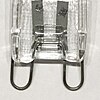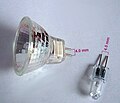Bipin
Bi-pin lamp base
Type of lamp/lightbulb fitting/connector
A bipin or bi-pin (sometimes referred to as two-pin, bipin cap or bipin socket) is a type of lamp fitting. They are included in the IEC standard "IEC 60061 Lamp caps and holders together with gauges for the control of interchangeability and safety". They are used on many small incandescent light bulbs (especially halogen lamps), and for starters on some types of fluorescent lights.
Some sockets have pins placed closer together, preventing the low-power bulbs they use from being replaced by bulbs that are too high power, which may generate excessive heat and possibly cause a fire. These are sometimes called "mini-bipin". Where the terminals of the lamp are bent back onto the sides of the base of the bulb, this forms a wedge base, often used in small bulbs for automotive lighting.
The bi-pin base was invented by Reginald Fessenden for the 1893 World's Fair in Chicago.[citation needed] After Westinghouse won the contract to wire and illuminate the first electrified fair with AC instead of arch-rival Thomas Edison's DC, Edison and his General Electric company refused to allow his patented Edison screw-base bulbs to be used. Westinghouse overcame this by developing the bi-pin base for use at the fair. An incandescent electric lamp with a bi-pin base was patented by the Westinghouse (G. Westinghouse, Jr.) in 1895.[1][non-primary source needed]














